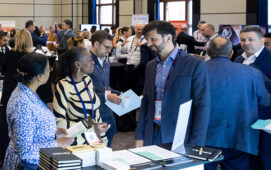
Richard Clements has a talent for explaining highly technical concepts in ways that make them sound as easy as listening to your favourite song. Which is apt, considering that the chief executive of VendEx, a vendor and data cataloguing technology provider, explains his company’s latest innovation with a guitar perched on a stand beside him.
The musical reference doesn’t end there, either. He compares VendEx’s newly patented Usage Rights Code (URC) technology – a sophisticated system for capturing and managing the entitlements that users possess in data contracts – as providing a service akin to a music streaming service for financial institutions’ data teams.
“How do you consume your music?” he asks Data Management Insight over a video call from his office in San Francisco. “With your licence you have the right to utilise that music on your personal device, in your home or in your car, you don’t have the rights to put that music in a podcast, play it at a bar, put it to movie or put it on the radio.
“Those are different usage rights that come with different commercial models – it’s the same thing in our world.”
Contractual Limits
VendEx’s URC is still in development but Clements anticipates that when it is ready to be rolled out the technology will fill a crucial gap in the data management space.
As institutions integrate ever-greater volumes of data, they are likely to hit upon more limits to the way they can use it. For many users those limitations may not be easily apparent. VendEx’s URC provides that information, enabling clients of the many thousands of data vendors and aggregators to see immediately how they can avoid breaching the usage rights of the data they licence.
With that sort of transparency, institutions can forfend against audits and investigations that could cost them dearly in financial terms and also in reputational damage. Clements said that usage rights breaches have become commonplace to the extent that even Silicon Valley giants have been caught out.
They “are asking forgiveness, not permission, and utilising data they don’t have the rights to,” he says. Generative artificial intelligence’s (GenAI) indiscriminate use of data is going to inevitably lead to legal disputes, he adds.
“In large language models, we see a multitude of lawsuits,” he said.
VendEx’s URC database is populated with the legalese and terms of many thousands of data usage contracts that its engineers, led by Chief Data Officer Michele Kelsey, have scoured over many years to isolate the individual permissions and restrictions that are contained within them.
These have been matched to the datasets to which they apply so that organisations wishing to licence or access those products know how they can be used.
Disciplined Work
VendEx’s technology extracts three categories of information, Kelsey explains. They include legal terms, which are important to vendors and consumers but less so to brokers who may neglect to inform customers of such details. Vendex also identifies and captures commercial terms, which cover details like the number of licences issued for the data and how long the contracts last. Finally, it draws out permitted and prohibited uses, the wording that describes how that data may be utilised.
That information is then contained in an open-ended string of code and attached to the data within the URC.
Kelsey says that the process of mapping the different categories of details found in contracts to a systematic taxonomy required rigorous problem solving.
“There is a tremendous amount of discipline that goes into adding anything to the tables or seeing whether it is harmonised with another category,” she explains. “We have gone through tens of thousands of contracts to come out with every kind of constriction that they have put around data usage. This will be a continuous process as the market evolves. The market is always changing and so are the terms of the contracts.”
As VendEx develops its URC, it is already in negotiations to build a self-service model for a large client that will put the tool on the desktops of about 60,000 individual end users around the world.
“The end user will be able to go in and see what they have, how that can and cannot be used; what the firm has, and how that can and cannot be used; and, then what’s available in the marketplace,” Clements says. “It’s pretty cool the way this client is approaching the marketplace.”
Past Success
Clements has a long track record of finding digital solutions for financial institutions. The former Bank of America commercial paper trader formed VendEx from a consultancy he’d created after a spell as an executive at Bloomberg, where he ran Market Transparency, which included the message mining that fed its evaluated pricing engine, BVAL.
His company, International Solutions Network (ISN) was formed 15 years ago and played a substantial role in building the European Central Bank’s European Data Warehouse, putting together a consortium of data giants to bring the project to fruition in 2012.
VendEx grew from ISN and last year was granted its first patent, for its VendEx Identifier (VID), an alphanumeric code that standardises the categorisation and identification of data.
The VID has been created to make it easier for users and vendors to buy, sell and use data. It is also a core component of the URC, which depends on the accurate identification of data to enable users to understand their usage rights.
Future Development
While the URC is an effective means of showing the limitations that a data licence contains, it doesn’t automatically put barriers on the data’s usage to protect against breach of those contractual agreement. VendEx, however, is working with data governance technology provider Tractiv to do that.
“Tractiv does have monitors and controls that sit on top of the data so they can actually put guardrails around, or actually limitations on, that data usage,” said Clements.
He is confident that the URC’s code string format gives the tool the flexibility to adapt to a changing market.
“With AI, we’re going to see more and more use cases that we haven’t seen yet,” he says. “Will it refer back to the same tables we have now? Probably. But will we need to create a new table in the future? Definitely.”
Subscribe to our newsletter




